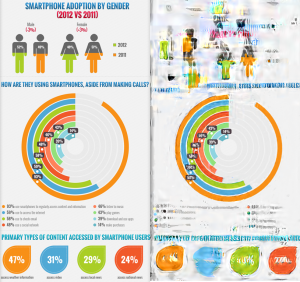So, you’ve got your landing page up and running — now what? Well, it all boils down to how well your landing page performs, and in order to get insight into the performance of your page, you must examine a number of different metrics.
Conversion rate is by far the most important metric that you need to identify when determining the success of a landing page. However, there are more metrics than the conversion rate. We’ll explore the top eight below.
Metric #1: Conversion Rate
The primary goal of most landing pages is to get contact information from the web user, which turns them into a lead and potentially provides the opportunity to convert them into a customer.
Every time someone visits your website, fills out the form, and clicks submit, this is referred to as a conversion. In some cases, the desired action on your landing page may be to click a certain link, subscribe to a newsletter, or purchase a product.
The conversion rate is basically the percentage of web users who take the preferred action. The conversion rate takes the total number of visitors and divides that by the number of conversions. That number is then multiplied by 100.
The average conversion rate for landing pages is roughly 2.35 percent. The top 25 percent of websites have conversion rates of at least 5.31%, while the top 10 percent have conversion rates of at least 11.45%.
Conversion rates do vary from one industry to the next, and these rates rely heavily on average website traffic, your online presence, and many other factors.
However, if you are converting below the top 25 percent of websites, it is time to make a change.
So, why are conversion rates so important? Put simply, the conversion rate will provide you with valuable insights into the actions people take once they get to your website, what brought them there in the first place, and what keeps them from taking the desired action.
Metric #2: Bounce Rate
The bounce rate can be defined as the percentage of web users who leave your website after only viewing a single page. Your bounce rate needs to remain as low as possible in order to obtain more conversions.
A high bounce rate is indicative of your landing page not being what visitors expected, usually in the form of content. Since they had no interest in the material they saw and taking action, they left the page without clicking on a link, completing a form, etc.
Generally speaking, your bounce rate will let you know several things. These may include that your landing page failed to deliver on the expected promise, the landing page design is vastly different from the ad they clicked on to get to your page, and the call-to-action can’t be found or is hard to find.
So, they simply don’t understand the page’s message, or they feel that the landing page is unappealing.
In other words, if you have a high bounce rate, your landing page is not meeting the expectations of visitors in one way or another.
The average landing page bounce rate is roughly 40.5 percent. Of course, the lower the bounce rate is, the better your landing page is performing.
Metric #3: Page Views
This is probably the most obvious metric that helps to determine the success of your landing page since it measures the number of people who are looking at your landing page.
Page Views metric allows you to see which pages are getting the most and least traffic.
When examining page views, you can also take a closer look into what prompted more page views and the time of day that people tend to visit your landing page.
This information can prove particularly beneficial if you’re running PPC ads.
Metric #4: Average Time Spent on Page
Keeping an eye on how long visitors are staying on your landing page can be useful. However, keep in mind that the kind of landing page you have can have a direct impact on this metric.
Therefore, a shorter or longer average time spent on the page doesn’t have to indicate that your landing page is not performing well.
For instance, an educational landing page is used to provide information to a visitor about how to use a product, a new feature, etc.
If the average time spent on this type of page is low, then it may be due to insufficient information, irrelevant information, or consuming information.
A low average time on a page means you need to examine the content on the page. You may need to make some changes so the material is easier to understand.
You may also want to consider incorporating additional images and resources.
Metric #5: Sessions by Source
It is incredibly important to know where it is that your visitors are coming from when they arrive at your landing page. This ultimately helps you get a bigger picture of how your campaign is performing.
By determining the channels that bring in converting traffic, you can learn more about what optimizations to make to your page and where to focus your ad spend.
For instance, if a large amount of your traffic is coming from Facebook and many of those leads convert, then you will want to consider investing more in the ads you’re using on that social media outlet.
At the same time, if you’re not getting a lot of traffic from a particular source, you need to improve your ads. You can also find out if your organic reach or your paid campaigns are bringing in more traffic and conversions.
Ideally, the more organic traffic you can get without having to shell out money for it, the better off you will be in the long run.
Metric #6: Cost Per Conversion
Since money is important, you will also want to keep an eye on the cost per conversion metric. This rate lets you know how much you are spending on acquiring each new lead.
While the goal is to increase the number of landing page conversions, you also don’t want to increase your costs significantly.
So, how do you calculate your cost per conversion? Simply divide the total cost you’re out for generating traffic by the total number of landing page conversions.
Metric #7: Form Abandonment
Form abandonment refers to the number of visitors who began to fill out a form on your website and then left the site.
There are numerous reasons why form abandonment may occur, including your form requesting sensitive details or too much information.
As you are building your form for higher conversion rates, keep in mind why you’re asking for the information in the form. In other words, it doesn’t make sense to give your phone number if you’re filling out a form to download an eBook.
Metric #8: Return vs. New Visitors
This metric is pretty straightforward in what it is—showing you the percentage of return and new visitors to your landing page.
Unfortunately, this is a metric that is often overlooked yet can offer important information regarding the engagement of your landing page.
New visitors are those who have landed on your page for the first time ever, whereas return visitors are those who have been to your landing page before and have returned.
Although all of the mentioned metrics are designed to work in tandem with one another under most circumstances, this particular metric can shed a lot of light on the performance of your page when used in conjunction with other metrics.
For instance, if new visitors are spending more time on your landing page than returning visitors, you should consider offering them something to get them to come back again, such as a special coupon code.
If your returning visitors have a higher bounce rate than new ones, then the quality/quantity of the content may not be as appealing.
They are coming back for more, but the content is lacking. Therefore, you will want to examine your content strategy and see where you can make improvements to reduce the bounce rate of returning visitors.
Bonus Tip: Track Landing Page Metrics That Matter with the Help of Interactive Content
Plain old landing pages are no longer as effective as they used to be thanks to the implementation of interactive content.
Interactive content is designed to make it easier for visitors to consume the information you are sharing with them. It can also make it easier to understand what your products/services and brand are about.
Interactive landing pages have the ability to increase your site’s visibility, drive additional traffic, and simply help you gain access to the landing page metrics that are most important to you.
Wrap Up
Regardless of the type of marketing campaign you’re running, you want to ensure that you are tracking and evaluating the right metrics.
In order to improve your overall conversion rates and overall performance of your landing page, the aforementioned nine metrics are ones that you need to track.
On top of these metrics, you will also want to give more thought to implementing an interactive landing page. Learn more about interactive content with this in-depth guide.
Ready to unlock the full potential of your landing page metrics?
Discover the transformative power of Ion in our Content Cloud suite. Visit our website now to explore how Content Cloud can streamline your content marketing efforts.
Start creating interactive content with Ion and increase your marketing results!
Start creating interactive content with Ion and increase your marketing results!


![[Rock NA] State of Marketing Reports 2024 – Comkt Hubspot State of Marketing Report 2024](https://rockcontent.com/wp-content/uploads/2022/07/Banner-Fino-Rock-Convert-2500-%C3%97-500-px-19.png)








